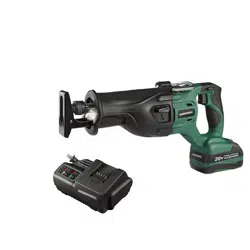Loading ...
Loading ...
Loading ...

Page 12
OPERATION
4. As the blade starts cutting, raise the
handle of the tool slowly until the shoe
rests firmly on the workpiece.
5. After the blade has penetrated through
the workpiece, guide the tool along your
cutting line to achieve the desired cut.
6. Release the trigger switch. Do not
remove the blade from the material
until the blade has completely stopped
moving.
NOTICE: To make plunge cutting easier,
use a heavy gauge blade and install the
blade with the teeth facing upward as
show in column B (FIG. 8).
WARNING:
To reduce the risk of
explosion, electric shock and property
damage, always check the work area for
hidden gas pipes, electrical wires or water
pipes when making blind or plunge cut.
WARNING:
To avoid loss of control
and serious injury, make sure that the
blade reaches maximum speed before
touching it to the workpiece.
WARNING:
Do not make plunge
cuts in metal materials.
METAL CUTTING
The saw can be used to cut metals, such
as sheet steel, pipe, steel rods, aluminum,
brass, and copper. Be careful not to twist or
bend the saw blade. Do not force.
The use of cutting oil is recommended when
cutting soft metals and steel. Cutting oil will
keep the blade cool, increase the cutting
action, and prolong blade life.
WARNING:
Never use gasoline,
because normal sparking could ignite the
fumes.
1. Securely clamp the workpiece in
position, and make the cut close to
the clamping point in order to minimize
vibration of the work being cut.
2. When cutting conduit pipe or angle iron,
clamp the work in a vise, if possible, and
cut close to the vise.
3. To cut thin sheet material, “sandwich”
the material between pieces of
hardboard or plywood, and clamp
the layers together in order to reduce
vibration and tearing of the material.
MAINTENANCE
WARNING:
Always wear safety
goggles or safety glasses with side
shields during power tool operations, or
when blowing dust. If operation is dusty,
also wear a dust mask.
WARNING:
Do not at any time let
brake uids, gasoline, petroleum‐based
products, penetrating oils, etc. come in
contact with plastic parts. Chemicals can
damage, weaken or destroy plastic, which
may result in serious personal injury.
MAINTENANCE
The tool may be cleaned most effectively
with compressed dry air. Always wear
safety goggles when cleaning tools with
compressed air.
Avoid using solvents when cleaning plastic
parts. Most plastics are susceptible to
damage from various types of commercial
solvents and may be damaged by their use.
Use clean cloths to remove dirt, dust, oil,
grease, etc.
Loading ...
Loading ...
Loading ...
